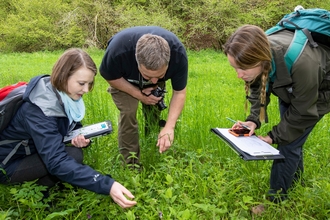Mapping and monitoring Gloucestershire's habitats to aid nature's recovery
Woodland • Grassland • River • Heathland
Cropland • Wetland • Garden • Orchard
Knowing what grows where is fundamental to restoring nature and protecting against climate change.
Landowners, farmers and land managers
Landholders include estates, farms, commercial premises and charities; parish and government owned land; road verges, schools and other infrastructure land; church and diocese holdings and more.
The HabiMap team only survey countryside where the landholder (owner, leasee or tenant) has given permission.
Surveys and reports are:
- Free
- Undertaken by trained citizen scientists (community volunteers)
- Very low or no impact
What are the benefits to farmers and landowners of accurate and up to date habitat data?
- Providing information that could help access agri-environment funding such as the future Environmental Land Management payments for public goods, which, is based on maintaining/increasing the ecosystem services we benefit from.
- Identifying opportunities to access stacked funding (multiple sources) for delivering different ecosystem services on land.
- Creating opportunities to participate in funded environmental projects, such as delivering biodiversity net gain for developers.
- Potential for increased knowledge of the wildlife on your land.
Habitat surveys do not affect control you have over your land, or potential future development, as that is already regulated through the planning system.
Analysis and recommendations are reported back to land managers by arrangement to help close the gap in the evidence-based management cycle of manage / monitor / manage.
HabiMap works closely with the GWT Environmental Land Management Scheme trial.
Due to the potentially huge amount of landholder data involved, HabiMap is not set up to survey urban areas yet – including for people to survey their own gardens - but we’re working on it.


